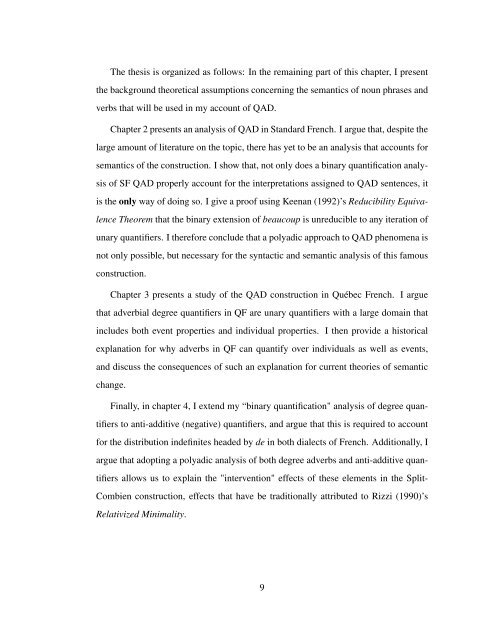Formal Approaches to Semantic Microvariation: Adverbial ...
Formal Approaches to Semantic Microvariation: Adverbial ...
Formal Approaches to Semantic Microvariation: Adverbial ...
You also want an ePaper? Increase the reach of your titles
YUMPU automatically turns print PDFs into web optimized ePapers that Google loves.
The thesis is organized as follows: In the remaining part of this chapter, I present<br />
the background theoretical assumptions concerning the semantics of noun phrases and<br />
verbs that will be used in my account of QAD.<br />
Chapter 2 presents an analysis of QAD in Standard French. I argue that, despite the<br />
large amount of literature on the <strong>to</strong>pic, there has yet <strong>to</strong> be an analysis that accounts for<br />
semantics of the construction. I show that, not only does a binary quantification analysis<br />
of SF QAD properly account for the interpretations assigned <strong>to</strong> QAD sentences, it<br />
is the only way of doing so. I give a proof using Keenan (1992)’s Reducibility Equivalence<br />
Theorem that the binary extension of beaucoup is unreducible <strong>to</strong> any iteration of<br />
unary quantifiers. I therefore conclude that a polyadic approach <strong>to</strong> QAD phenomena is<br />
not only possible, but necessary for the syntactic and semantic analysis of this famous<br />
construction.<br />
Chapter 3 presents a study of the QAD construction in Québec French. I argue<br />
that adverbial degree quantifiers in QF are unary quantifiers with a large domain that<br />
includes both event properties and individual properties. I then provide a his<strong>to</strong>rical<br />
explanation for why adverbs in QF can quantify over individuals as well as events,<br />
and discuss the consequences of such an explanation for current theories of semantic<br />
change.<br />
Finally, in chapter 4, I extend my “binary quantification" analysis of degree quantifiers<br />
<strong>to</strong> anti-additive (negative) quantifiers, and argue that this is required <strong>to</strong> account<br />
for the distribution indefinites headed by de in both dialects of French. Additionally, I<br />
argue that adopting a polyadic analysis of both degree adverbs and anti-additive quantifiers<br />
allows us <strong>to</strong> explain the "intervention" effects of these elements in the Split-<br />
Combien construction, effects that have be traditionally attributed <strong>to</strong> Rizzi (1990)’s<br />
Relativized Minimality.<br />
9
















